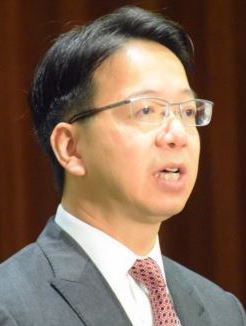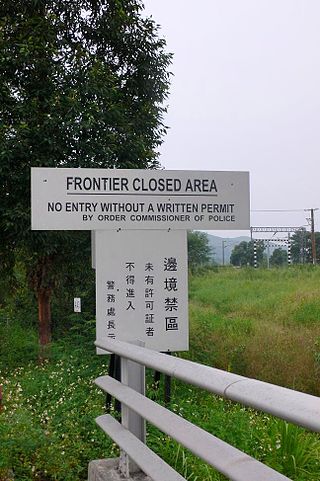
New Kowloon is an area in Hong Kong, bounded in the south by Boundary Street, and in the north by the ranges of the Eagle's Nest, Beacon Hill, Lion Rock, Tate's Cairn and Kowloon Peak. It covers the present-day Kwun Tong District and Wong Tai Sin District, and part of the Sham Shui Po District and Kowloon City District.

Lee Tung Street, known as the Wedding Card Street by locals, was a street in Wan Chai, Hong Kong. The street was famed in Hong Kong and abroad as a centre for publishing and for the manufacturing of wedding cards and other similar items.

North Lantau New Town is the newest of the nine new towns in Hong Kong, a special administrative region of China, located on the northern coast of the Lantau Island in the New Territories. It covers Tung Chung, Tai Ho Wan, Siu Ho Wan, other parts of northeast Lantau Island, and the reclaimed land along the coast between them. It is the only new town in the Islands District and the youngest new town in Hong Kong. As the commercial, residential and community facilities in the New Town are concentrated in Tung Chung, it has been renamed Tung Chung New Town in recent official government documents.

The Guangzhou–Kowloon through train is an inter-city railway service between Hong Kong and Guangzhou jointly operated by the MTR Corporation of Hong Kong and the Guangzhou Railway Group of mainland China. Services operate along the East Rail line within Hong Kong territory, crossing the Hong Kong–Chinese border at Lo Wu, and continuing along the Guangmao Railway and Guangshen Railway in Guangdong province.

The Antiquities Advisory Board (AAB) is a statutory body of the Hong Kong Special Administrative Region with the responsibility of advising the Antiquities Authority on any matters relating to antiquities and monuments. The AAB was established in 1976 along with the Antiquities and Monuments Office (AMO) when the Antiquities and Monuments Ordinance (Cap. 53) was enacted, and comprises members appointed by the Chief Executive. The corresponding governmental ministry is the Development Bureau, and executive support for the AAB is provided by the AMO which is under the Development Bureau.

Tai Hom Village was the largest squatter village in Kowloon, Hong Kong. Its demolition was completed in 2001, with a few structures of historical value being preserved. The name is still used to designate its former site in Wong Tai Sin District, which is awaiting redevelopment.
In January 2012, Peking University professor Kong Qingdong made televised remarks suggesting that many Hong Kong people were disloyal to China and still harboured a colonial mentality. Kong Qingdong called Hong Kong people "dogs" in response to an online video posted about a mainland Chinese child eating on the subway, which is prohibited by MTR regulations. This prompted a series of campaigns against Kong Qingdong in Hong Kong. About 150 people gathered at the Central Government's Liaison Office on 22 January to protest Kong's remarks.
The Hong Kong mainland China driving scheme is a cross-border driving scheme which allows drivers of cars with primary registration in mainland China to drive directly to Hong Kong. Currently, mainland cars have the driver seat on the left, while HK cars have driver seat on the right. Historically HK was a British colony before 1997, and adopted driving on the same side of the road as the United Kingdom.

The Kai Tak Development, abbreviated as "KTD" and formerly called South East Kowloon Development (東南九龍發展計劃), refers to the redevelopment of the former Kai Tak Airport site in Kai Tak, Kowloon, Hong Kong.
Dai pai dong is a kind of traditional food stall in Hong Kong. It was famous and popular in Hong Kong during the 1960s and 1970s. The literal meaning of dai pai dong in English is “Big license stall”. The characteristics of Dai Pai Dong are lack of air-conditioners, unclean environment but various kinds of food. However, starting from 1980s, the government stopped issuing new licenses and began buying them back. Due to its hygienic problem and the deaths of the license holders, dai pai dong closed down and was replaced by different kinds of restaurant. There are only 25 dai pai dong left in Hong Kong, according to the Food and Environmental Hygiene Department, which manages the licenses. Nevertheless, because of voices about preserving local food culture, it is suggested that licenses should be issued again to the vendors and the dai pai dong owners. Besides, there are several changes of dai pai dong due to the urban development.
In Hong Kong, the suicide rate of primary, secondary, and post-secondary students is relatively high, particularly beginning in the 2014–2015 academic year. The suicide cases are not connected, but the frequency of suicides aroused public's attention to the mental health and academic pressure of Hong Kong students.

The 2018 Hong Kong Legislative Council by-election was held on 11 March 2018 for four of the six vacancies in the Legislative Council of Hong Kong (LegCo) - the Hong Kong Island, Kowloon West and New Territories East geographical constituencies and the Architectural, Surveying, Planning and Landscape functional constituency - resulting from the disqualification of six pro-democrat and localist camp Legislative Council members over the 2016 oath-taking controversy. The by-election for the two other seats was not held due to pending legal appeals by the two disqualified legislators.

The Policy Innovation and Co-ordination Office (PICO) was a creation in Carrie Lam's Policy Address in 2017 to revamp the Central Policy Unit. It has commenced operation since 1 April 2018, and ceased operation from 1 July 2022.

Chun Yeung Estate is a public housing estate in Fo Tan, New Territories, Hong Kong. It is the only public housing estate in Fo Tan, located at the junction of Wong Chuk Yeung Street and Kwei Tei Street. It comprises 5 blocks and 1 shopping centre with total of 4,846 flats. Its name prefix "Chun" means "horse" in English since Sha Tin Racecourse is located in Fo Tan. It was completed in 2020.

Fai Ming Estate, former name "Fanling Area 49 Public Housing Development", is a public housing estate on Fai Ming Road in Fanling, New Territories, Hong Kong, next to Yung Shing Court. It was completed in 2019 and comprises two blocks with a total of 952 flats.

Cheng Tat-hung is a Hong Kong politician, formerly affiliated with the Civic Party. He is a former member of the Eastern District Council for Tanner since 2016 to 2021.
Wong Ho-wa is a Hong Kong data scientist and pro-democracy activist. He led the open government data community g0vhk from 2016 to 2021. He was an Election Committee member representing the information technology (IT) industry from 2016 to 2021 and ran for the Information Technology constituency in the 2020 Hong Kong legislative election as part of the pro-democratic caucus.
Public housing estates in Hong Kong are the most common kind of public housing in Hong Kong. Typically, estate units are leased to low-income people. There are three organizations that provide housing units. They are Hong Kong Housing Authority (HKHA), Hong Kong Housing Society (HKHS), and Hong Kong Settlers Housing Corporation Limited.












